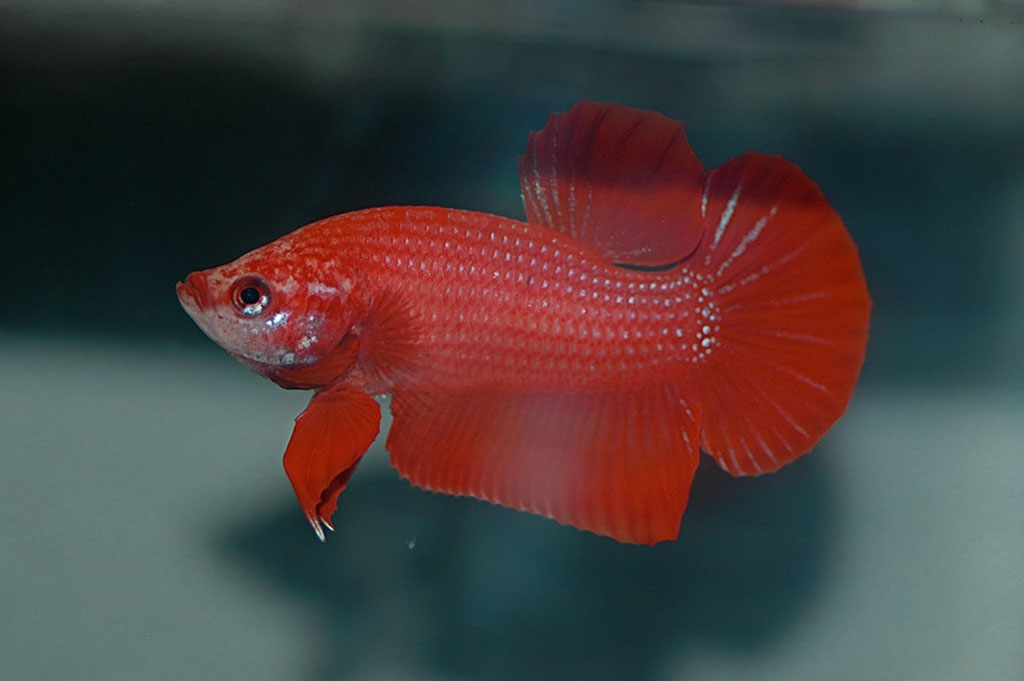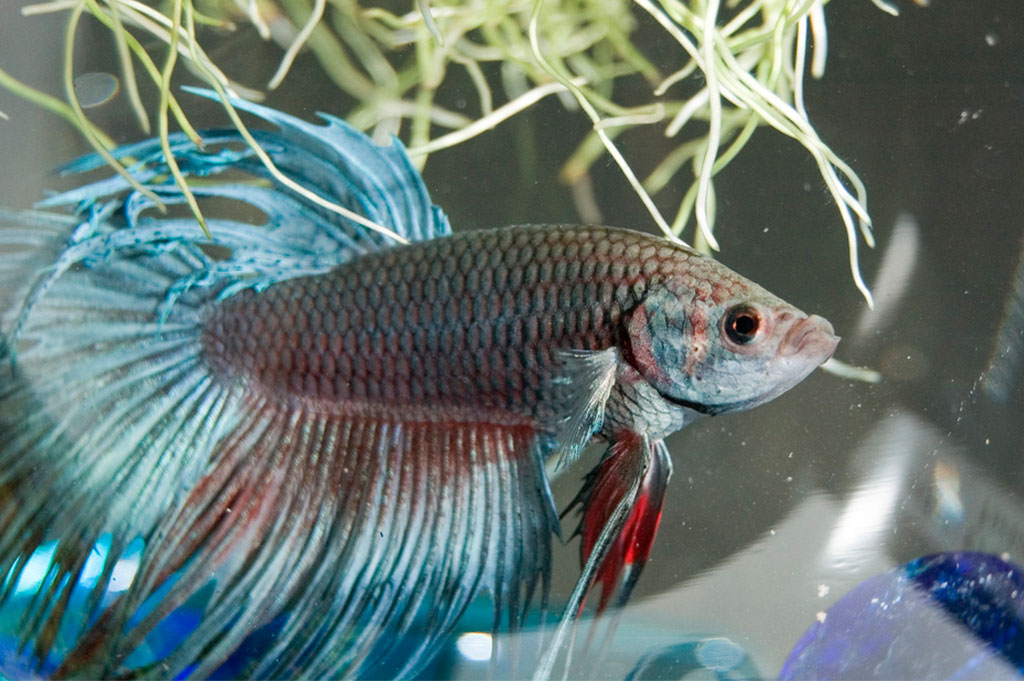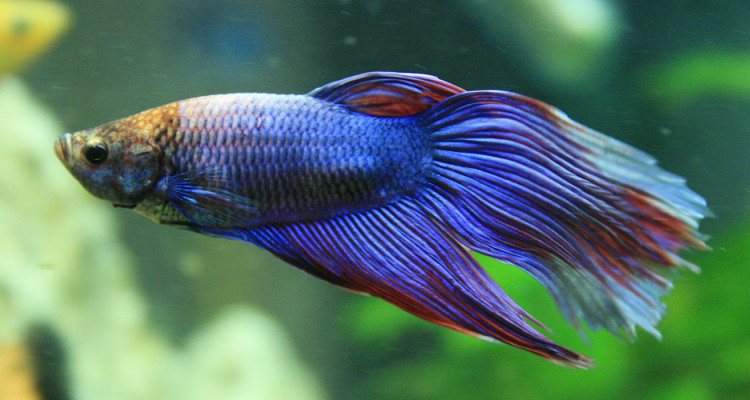The Betta fish, Siamese fighting fish, or betta as it’s known by its genus, is an elegant tropical freshwater fish that is popular as a pet and often housed in eclectic home aquariums. In the wild, native to areas like Cambodia and Thailand, the betta inhabits rice paddies and still watered canals.
The ones you see in pet stores are quite different too in both color and size, with wild betta fish having much smaller fins and being predominantly colored in a dull green or brown appearance.They’re a wonderful first pet to teach children the responsibility of caring for something, and are inexpensive to purchase and maintain.
Males and females look drastically different from each other, with males exhibiting the longer beautiful flowing fins. Females are much smaller in size and fin length. With proper care bettas can live anywhere from 2 to 4 years, with some owners having noted lifespans that extended into their teens. Pretty neat huh?
Some History
Let’s explore more of the history of the betta and why everyone knows them for fighting their own kind. Back in the mid to late 1800’s, the King of Thailand took an interest in the betta because of the species’ territorial nature and fighting instinct.
Natives would collect and breed them specifically for fighting matches and this caught the attention of the King for sport. The King would keep his victors close and became so engrossed in the sport that he later sanctioned regular events, taxes, and bets were even placed on the fights.
Despite many believing that bettas fight to the death, that’s not always the case. Typical fights between bettas last only a few minutes before one decides to retreat or dies. This explains why bets were placed on the bravery of each fish back in the 1800’s rather than who would survive the other. After tiring from battle, one betta will retreat signaling victory to other.
Because the betta’s natural environment in the wild would change so often, they developed the ability to intake oxygen from both the water and the air. This genetic evolutionary trait allows the species to live in water that contains very little oxygen.
If you have a betta as a pet you will see that they come to the surface often to suck air from outside the water. Believe it or not, but a betta can survive outside the water for a period of time as long as they remain wet. There are many pet owner stories of betta’s jumping out of their tanks and surviving for more than a day outside of their tanks.

Behavioral Characteristics
Fish are most known for traveling in large packs or schools, however the betta prefers to be independent both in captivity and the wild. This is the reason that in captivity and placed in the same tank, male bettas will fight with one another. Oddly enough some bettas don’t fight at all.
In the wild this species has more room to be independent and retreat, but in a tank this can lead to territorial matches. After breeding fighting can also occur by a male against the female and therefore they should be separated immediately after.
If a male betta becomes bored, it may start to bite at it’s own fins which can lead to disease. A tank that is at the very least 2 gallons and contains plants and hiding spots is recommended to prevent this. Betta fish can live with other fish and play nice so long as the other fish have small fins. Other inhabitants that have bright colors and large fins will often prompt the betta to start biting and killing these fish.
Female bettas in larger groups can actually live together in the same tank as long as it is at least 10 gallons in size. Caution should still be exercised and the owner will need to monitor the ‘sorority’ of female bettas to ensure that they do not start to fight each other. If one fish seems to be the aggressor, she may need to be removed and transported to a new tank by herself.
Males and females like to put on shows as they flare their gills out in an effort to attract the opposite sex or as an act of intimidation. When inside a tank, the betta will flare out its gills if it feels threatened or gets frightened. This can be seen by approaching the tank very quickly, or when a male is building and protecting its bubble nest.
Another characteristic when frightened is the appearance of horizontal lines on the bettas sides. The exact opposite, or vertical lines, are prominently displayed during a females attempt to show health and mating readiness.
10 Interesting Facts
- Betta fish like warm water and will do best at around 79 degrees.
- Science accounts for a total of 73 species of the betta in the world, with several according to the IUCN Red List being endangered.
- Overfeeding your betta may lead to the fish not being able to swim to deeper depths of the tank as it becomes obese and bloated. Overfeeding will also lead to an unhealthy and dirty tank much quicker.
- Breeders have developed variations in colors and fins over time to appeal to pet owners.
- They are a carnivorous species which means they love meat! To ensure proper health and diet, make sure all pellets are high in fish or shrimp.
- Bettas have a unique organ called the labyrinth to breathe air outside of the water.
- Males build bubble nests on the surface of the water to attract females, even if one is not in the tank.
- Bettas like to jump and sometimes jump right out of the tank! Make sure you have a lid.
- Microsoft, Inc. has used pictures of bettas on desktop backgrounds during the beta tests of their newer Windows operating systems. This also sheds light on the commonly misspelled name.
- After mating, the male chases the female away and protects the eggs and the bubble nest where they were laid. If the female is allowed to stay for extended period of time she will begin eating the eggs that she spawned.

Anatomy of the Betta Fish
The most unique part of the betta is the labyrinth organ mentioned above. Over time and from living in harsh shallow water environments such as the rice paddies, the betta evolved and is now able to suck air from the water’s surface and immediately absorb the oxygen into the body. Without this adaptation the betta species may not have been able to survive.
Both males and females have an elongated body and vary in color in the wild and in captivity depending on breeding. Their stomachs are extremely tiny and this needs to be taken into consideration when feeding your betta. To put this into some perspective, bettas have two eyes and their stomach is roughly the size of one of their eyes!
All bettas also have visible fins, and gills which are used to consume oxygen into the body from the water. Lastly, you might wonder how a betta is able to sleep while submerged. The use of the swim bladder allows bettas to control their depth in the water by inflating or deflating this bladder inside their bodies. Suffering from SBD or swim bladder disorder is actually quite common and can result from overfeeding. When you break down all the parts of the betta, they are one awesome fish.

Misconceptions
Despite Siamese fighting fish (Betta splendens) being sold in pet stores and given as gifts in small cups and vases, they need a larger habitat if they are going to live a healthy and long life. Bettas can also inhabit tanks with other fish species.
Bettas also cannot sustain a healthy life by living in a vase and feeding off of the roots of a plant like many believe is the case. This lack of education on behalf of owners leads to what PETA calls, “being sentenced to a dull, lonely, and slow death from starvation.” Bettas are omnivores in nature, and therefore in captivity need meats and other nutrients to remain healthy.
While the betta can survive at room temperature water, it may impair their immune system or lead to inactivity if the water becomes too cold. Since they thrive at around 79 degrees, it’s important to remember that the air around the tank is always at least a few degrees higher than the actual water temperature.
The average room temperature in a home is 68 degrees, so it’s crucial that you have a heater in colder months if the water temperature drops too low. Failure to do so could lead to health concerns.
Another misconception is that the betta fish does not need a filter because it is used to living in stagnant and dirty water (e.g. large puddles). Ammonia however builds up in the tank from defecation and can hurt the fish over time through fin rot and other diseases.
This leaves you with two options which are either to change the water often, or install a filter to remove the toxins from the water. The safest way to maintain the healthiest environment is through the use of a slow and gentle filter to prevent their fins from getting sucked into it.
(Source: bettafish.org)
